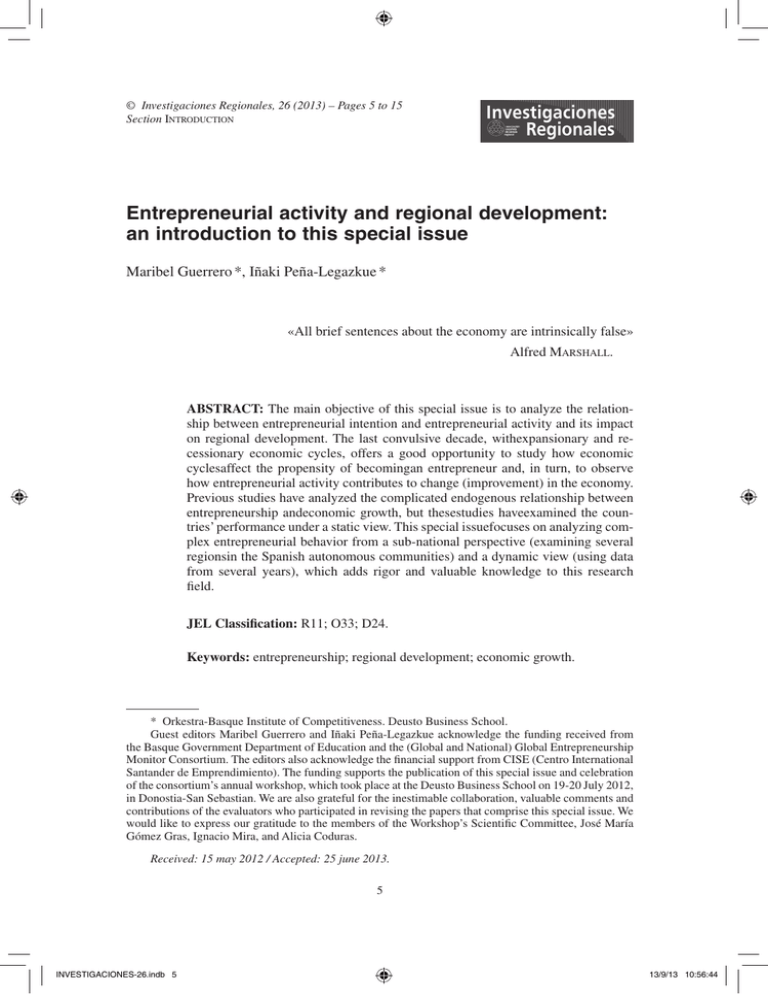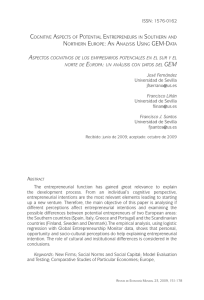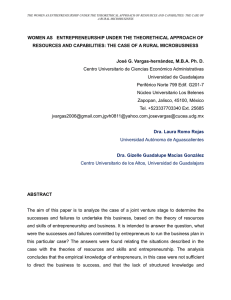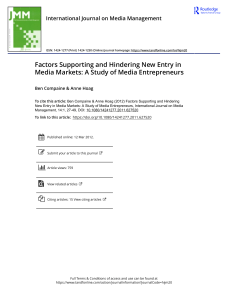Entrepreneurial activity and regional development: an introduction to
Anuncio

© Investigaciones Regionales, 26 (2013) – Pages 5 to 15 Section Introduction Entrepreneurial activity and regional development: an introduction to this special issue Maribel Guerrero *, Iñaki Peña-Legazkue * «All brief sentences about the economy are intrinsically false» Alfred Marshall. ABSTRACT: The main objective of this special issue is to analyze the relationship between entrepreneurial intention and entrepreneurial activity and its impact on regional development. The last convulsive decade, withexpansionary and recessionary economic cycles, offers a good opportunity to study how economic cyclesaffect the propensity of becomingan entrepreneur and, in turn, to observe how entrepreneurial activity contributes to change (improvement) in the economy. Previous studies have analyzed the complicated endogenous relationship between entrepreneurship andeconomic growth, but thesestudies haveexamined the countries’ performance under a static view. This special issuefocuses on analyzing complex entrepreneurial behavior from a sub-national perspective (examining several regionsin the Spanish autonomous communities) and a dynamic view (using data from several years), which adds rigor and valuable knowledge to this research field. JEL Classification: R11; O33; D24. Keywords: entrepreneurship; regional development; economic growth. * Orkestra-Basque Institute of Competitiveness. Deusto Business School. Guest editors Maribel Guerrero and Iñaki Peña-Legazkue acknowledge the funding received from the Basque Government Department of Education and the (Global and National) Global Entrepreneurship Monitor Consortium. The editors also acknowledge the financial support from CISE (Centro International Santander de Emprendimiento). The funding supports the publication of this special issue and celebration of the consortium’s annual workshop, which took place at the Deusto Business School on 19-20 July 2012, in Donostia-San Sebastian. We are also grateful for the inestimable collaboration, valuable comments and contributions of the evaluators who participated in revising the papers that comprise this special issue. We would like to express our gratitude to the members of the Workshop’s Scientific Committee, José María Gómez Gras, Ignacio Mira, and Alicia Coduras. Received: 15 may 2012 / Accepted: 25 june 2013. 5 INVESTIGACIONES-26.indb 5 13/9/13 10:56:44 6 Guerrero, M. and Peña-Legazkue, I. Actividad emprendedora y desarrollo regional: una introducción al número monográfico RESUMEN: Uno de los objetivos principales de este número monográfico es analizar la relación existente entre la intención y la actividad emprendedora, y su incidencia en el desarrollo regional. Esta última década convulsa, con ciclos económicos expansivos y contractivos, ofrece una buena oportunidad para estudiar cómo la coyuntura económica afecta a la propensión emprendedora, y, a su vez, para observar hasta qué punto la actividad emprendedora contribuye al cambio (mejora) de la economía. Existen numerosos estudios que han analizado esta complicada relación endógena entre emprendimiento y crecimiento económico, pero la mayoría de los trabajos de investigación han partido del análisis del comportamiento de países y bajo una visión estática. En este número monográfico, la mayoría de los estudios analizan el complejo comportamiento emprendedor desde una perspectiva sub-nacional (regiones de las Comunidades Autónomas de España) y desde una óptica dinámica (con datos de varios años recientes), lo que añade rigor y valioso conocimiento a esta disciplina. Clasificación JEL: R11; O33; D24. Palabras clave: emprendimiento; desarrollo regional; crecimiento económico. 1. Introduction For several decades, the determinant factors of a region’s wealth have been present in academic and political debate. The heterogeneity (and disparity) in economic welfare rates globally makes it clear that certain regions have developed capabilities over time to preserve —and even to increase— their comparative advantage in terms of GDP per capita. This leads us to think that certain regions have some idiosyncratic capabilities that are exceptional for successful economic development but that sometimes these capabilities work to the detriment of social, environmental and human development. The discovery and analysis of these regional capabilities could require a lot of time and effort to debate. And furthermore, even if we were to reach a consensus on the properties of these capabilities, extrapolating them for imitative construction and application to other regions could be a dangerous exercise, since the contexts are different and not all regions have the same absorptive capacity. In the second half of the past century, Nobel Prize laureate Robert Solow attributed economic growth to technical change or, in other words, to technological progress beyond the optimum allocation of resources (labor force and capital). Adopting a neoclassical approach, previous studies have analyzed the key determinants of economic growth. For instance, some authors found that the main causes were the positive externalities stemming from information (Arrow, 1962), innovation (Griliches, 1979) and knowledge (Romer, 1986). Interestingly, these concepts are linked to the improvement of organizations’ productivity and, therefore, with a region’s economic development. Investigaciones Regionales, 26 (2013) – Pages 5 to 15 INVESTIGACIONES-26.indb 6 13/9/13 10:56:44 Entrepreneurial activity and regional development: an introduction to this especial issue 7 History has evidenced that investment in R&D and innovation is not enough to support economic growth. This investment must be recouped, and this implies that the market should pay above the investment in innovation. An excellent innovation capacity is meaningless if it is not accompanied by an ability to generate value. More than a decade ago, one of Europe’s top leaders, Romano Prodi, indicated that European countries were not growing enough for the efforts in innovation that took place on this continent. It is well known that Europe has not fulfilled the target agreed upon in the Lisbon Agreement of reaching a 3% investment in R&D over GDP for 2010. However, what is even more worrying is that today Europe lacks a strong ability to transform into value all the investments in R&D and innovation. Audretsch and Keilbach (2004) argue that a region must be endowed with entrepreneurship capital that enables the channeling of innovation into the market and thereby contributes to economic growth. This channeling process is complex and obstacle-ridden. Some of the barriers are those of the market itself; others are institutional, cultural and so on. Only by overcoming these barriers can knowledge filters create value in the market and improve productivity of resources. González et al. (2009) argue that this process could trigger a virtuous cycle of development: «while region’s innovation capital and entrepreneurship capital may affect the achievement of higher levels of productivity, competiveness and economic welfare, it is also true that the level of prosperity may well affect the enrichment of innovation capital and entrepreneurship capital». Precisely, this endogenous phenomenon can explain in part the persistence of the disparity among regions in their respective levels of welfare as well as the impact that certain regional capabilities (such as innovation and entrepreneurial success) have on their economies. The growing interest in this debate gave rise to the «Entrepreneurial Activity and Regional Development» workshop organized by the Orkestra-Basque Institute of Competitiveness, in San Sebastian on 19th-20th July 2012. The workshop brought together numerous national and international researchers to discuss themes related to entrepreneurial intention and the creation of new business in expansionary and recessionary economic periods. This special issue includes several papers that were presented during this event, which offer a rich diversity of conceptual frameworks and methods, as well as an eclectic perspective of this phenomenon. The majority of papers do share a common element; they used data provided by the GEM (Global Entrepreneurship Monitor) project, which has opened new possibilities for study. This special issue has two objectives. First, we want to delve into entrepreneurship as a driving force of economic development. We intend to examine the reasons that motivate the creation of new businesses, through the study of the effect caused by both individual and contextual factors. Second, we want to study this phenomenon during different economic expansion and contraction. We have witnessed significant changes in the Spanish economy during the recent decade. Working out what effect said changes have on entrepreneurial activity and, reciprocally, what effect the creation of companies has on economic development is (and will continue to be) an important research challenge. Investigaciones Regionales, 26 (2013) – Pages 5 to 15 INVESTIGACIONES-26.indb 7 13/9/13 10:56:44 8 Guerrero, M. and Peña-Legazkue, I. The contributions of this special issue, although modest, are remarkable, and provide at least two interesting contributions to the literature in this field. On one hand, the papers explore a diverse range of contexts (investment, university, social and economic contexts) and their links to entrepreneurial behavior in Spanish regions. This diversity of perspectives allows for a better understanding of the topic. On the other hand, the papers analyze different entrepreneurial agents, such as the person who has a business idea (the person who is potentially an entrepreneur but who has not yet started up a business), the person who has created a company, or the person who has invested in and accompanies a project (a business angel). The recognition and study of all these agents who belong to a region’s entrepreneurial ecosystem gives us a more accurate view of the way entrepreneurship capital works, which is so important for economic development and about which we know so little, according to Audretsch and Keilbach (2004). On the other hand, this special issue highlights a few key points aimed at those public authorities who are responsible for the design and implementation of policies and actions that foster entrepreneurship. As well as the demography and entrepreneurship experiments changes and transformation by the creation of new business, closing of established business, with the more or less long-lived survival of start-ups, and so on, public policies also appear, disappear and are reinvented over time. Our interest in this issue is to prompt new reflections and debate among the academic community and public policy makers about the complex relationship between entrepreneurial activity and regional development. 2. Research Interest on «Entrepreneurial Activity and Regional Development» Many authors argue that entrepreneurial activity is an important driving force behind regional development. Some of the arguments put forward to support this assertion refer to the higher market competition and the increased productivity attained with the appearance of new entrepreneurs. Certainly, entrepreneurs can inject not only greater efficiency into the market but also a higher dose of innovation through the development of new technologies (acknowledging that a percentage of those technologies also become disruptive). Following Audretsch and Keilbach’s (2004) reasoning, economic growth can be explained by the traditional production factors (capital and labor force), but they add the effect of a region’s innovative and entrepreneurial capacity. In particular, the authors propose the following expression: Yi = α K iβ1 Lβi 2 Riβ3 Eiβ4 ε (1) where Y reflects the production of a region i, α represents productivity, K refers to physical capital, L describes labor force, R reflects knowledge capital, E denotes entrepreneurship capital and ε would be the error term. This expression is an Investigaciones Regionales, 26 (2013) – Pages 5 to 15 INVESTIGACIONES-26.indb 8 13/9/13 10:56:45 Entrepreneurial activity and regional development: an introduction to this especial issue 9 extended version of the orthodox production function, with the added complements of innovation (Romer) and entrepreneurship (Audretsch) resources, which are necessary for economic growth. There are alternate ways to interpret this relationship. For example, González et al. (2012) propose a relationship where growth depends on productivity (α) and on physical (tangible) resources such as capital K and labor force L. However, these authors propose a new expression where the productivity that symbolizes technological progress is directly correlated to the region’s innovative and entrepreneurial capability; that is, αit (Ri, Ei). K Yit = α it ( Ri , Ei ) it Lit Lit β (2) In this model, innovation and entrepreneurship are conceived as intangible capacities instead of physical resources, which affect regional productivity over time, t, and, therefore, on the economic development (growth) of a region, i. Certainly, the complexity of the phenomenon still allows for the introduction of new interpretations of the relationship between entrepreneurial activity and economic development. As proof of this interest and of the evolution this field of study is undergoing, it is worth noting that since the last decade of the past century at least four special issues have been published on this subject in two recognized foreign journals: two in Regional Studies and two in Small Business Economics. At a national level, Investigaciones Regionales devoted an interesting issue to this theme in 2009; and our special issue would be a continuation of that concept. In 1994, Regional Studies published the special issue coordinated by Reynolds, Storey and West head, who included papers that studied the determinant factors on the variation of entrepreneurship rates in seven countries (Germany, France, Italy, Ireland, the United Kingdom, Sweden and the United States). The main conclusions extracted from this 1994 special issue were (1) that the differences on entrepreneurship rates were negligible, (2) that country conditions had a relevant impact on the lower/higher rate of business creation and (3) that entrepreneurial activity was a necessary condition but not sufficient for economic growth. Ten years later, Acs and Storey (2004) coordinated another special issue for Regional Studies, focusing on the relationship between entrepreneurship and economic growth. The authors studied the effect of entrepreneurial activity on economic development in four countries (Germany, Hungary, United Kingdom and United States) and in four different economic periods. Three of the four studies found that entrepreneurial activity had a positive effect on economic growth —not directly, but rather through the building of a more competitive economy—. This conclusion questioned the immediate effect that business creation could have on the economy. Acs and Szerb (2007) introduced the public policy component within this relationship in a special issue published in Small Business Economics. They recomInvestigaciones Regionales, 26 (2013) – Pages 5 to 15 INVESTIGACIONES-26.indb 9 13/9/13 10:56:45 10 Guerrero, M. and Peña-Legazkue, I. mended to emphasize the idea that «one-size-fits-all» policies —or, in similar terms, «a cookie-cutter approach»— will not work given the enormous diversity of socioeconomic and cultural contexts. Middle-income countries should focus on improving their human capital and technological infrastructures, while high-income countries should invest in labor force and finance reforms to ensure the success of high-growth start-ups. Therefore, public policy makers should pay attention not only to the quantity but also to the quality of entrepreneurial activity. In 2008, Fritsch coordinated a new special issue for Small Business Economics, which intended to measure the delay that occurs in entrepreneurial activity’s effect on the economic growth in Germany, Spain, Portugal, Holland, Germany, the United States and 21 OECD countries. The special issue indicated that this delay will last at least 10 years, and that the effect of each and every one of the entrepreneurs is not uniform. Gazelle firms (those that grow at rates above 20%, for example in employment for three consecutive years during their first five years of life) would most intensely influence this impact on the economy. In 2012, Audretsch and Peña coordinated another Small Business Economics special issue, of which two ideas stand out. First, the regional heterogeneity that exists within each country should not be ignored when conducting research studies. Therefore, studies must choose to focus on smaller-scale geographical areas in order to reach more accurate conclusions. Second, a bi-directional causal relationship must be recognized. Until now, in previous special issues, the effect of entrepreneurial activity on economic growth had been analyzed. However, the level of an economy can influence, in turn, the characteristics of entrepreneurial activity in a region. At a national level, in 2009 Investigaciones Regionales devoted an interesting special issue coordinated by Professor Segarra to the subject of «Innovation, Entrepreneurship and Territory». This issue highlighted the relevance of analyzing business dynamics and innovation adopting a territorial perspective, given the growing synergy between two important disciplines such as industrial economics and spatial economics. Segarra (2009) pointed out that entrepreneurs —the missing link— set themselves up as agents of change and innovations. Entrepreneurs can both burst onto the market severely (following Schumpeter’s concept of «destructive creation») and contribute to regional development (following Audretsch’s concept of creative construction). 3. Contributions of this Special Issue The papers in this special issue are varied and their contributions reflect this diversity. Many of the papers are based on the exploitation of data from the GEM. Spanish researchers have been adhering to the GEM international consortium for more than a decade. GEM has been consolidated as a bench mark due to its emphasis on the regional study of this phenomenon, which is why many of the studies selected for this issue have used this data source. Investigaciones Regionales, 26 (2013) – Pages 5 to 15 INVESTIGACIONES-26.indb 10 13/9/13 10:56:45 Entrepreneurial activity and regional development: an introduction to this especial issue 11 Martínez, Mira and Gómez Gras’s paper analyzes the effect of human capital as well as individual perceptions (when faced with failure, business opportunities and their capacity to start up businesses) on the decision to create a new business during different economic conditions. This study covers the period between 2005 and 2011 and offers strong empirical evidence that the perceptual variations described above have a bearing on the decision to start a business. For example, the binomial logistic regression analysis shows that the perception of having skills to create and develop a new business affects other variables (such as cultural, institutional, and so on) when launching a new business. This result is consistent regardless of the context (space and economic situation). Another interesting result suggests that opportunity perception encourages entrepreneurship markedly during periods of economic downturns. Another finding reveals that knowing other entrepreneurs also encourages entrepreneurship. Coduras and Autio’s investigation provides an analysis of the validity of the information provided by experts concerning the environmental conditions for starting up businesses in Spain. Several reports present numerous indicators to understand the environmental conditions, such as the Global Competitiveness Report prepared by the World Economic Forum, Doing Business published by the World Bank and so on. The national GEM consortium annually interviews 30 to 40 experts per autonomous community to find out their opinions on nine areas that describe different environmental conditions that influence entrepreneurship. The authors conclude that this information must be better utilized for conducting research work and for public decision making. A different approach is used by Vidal and López, who emphasize the role of institutional and economic factors during the identification of business opportunities. Using data from between 2004 and 2010 and applying a methodology based on a structural equation model, the authors agree with the previous study by Martínez et al., that entrepreneurial intention depends on perceptions about personal skills for starting businesses and the perception of business opportunities. Institutional factors, however, are not significant, or, if applicable, their effect turns out to be the opposite of what was expected. Following an individual perspective, Capelleras, Contín-Pilart, Martín-Sánchez and Larraza-Kintana’s paper provides a better understanding of how individual perceptions affect the decision to start a new firm (nascent entrepreneurship) and how this decision is also contingent upon the context in which actions are taken (urban/ rural environment). Using data from the Spanish GEM project, the results of a series of logistic regression models indicate that opportunity perception and self-efficacy have a positive influence on the probability of becoming a nascent entrepreneur. Interestingly, the authors also find that individuals in rural areas who perceive new opportunities are more likely to become nascent entrepreneurs than those who live in urban areas. Neira, Portela, Cancela and Calvo’s paper added to previous findings that entrepreneurial activity motivated by the need to be self-employed is related to a percepInvestigaciones Regionales, 26 (2013) – Pages 5 to 15 INVESTIGACIONES-26.indb 11 13/9/13 10:56:45 12 Guerrero, M. and Peña-Legazkue, I. tion of a greater fear of failure. The authors conclude that it can generate a dynamic that is detrimental for entrepreneurial activity in the middle term. Obtained by adopting a log it regression analysis, these results confirm to a large extent the results obtained by the rest of the studies in this special issue. University context, as the cradle of potential and future entrepreneurs, regains special importance in the paper developed by Rueda, Fernández-Laviada and Herrero. Based on the theory of reasoned action and using a structural equation model, the authors argue the perceived advantages of entrepreneurship influence positively on the attitudes of Cantabrian university students and their start-up intentions. Conversely, the disadvantages associated with entrepreneurship are not significant when it comes to influencing their attitudes and intentions. In this context, Poblete and Amorós paper explores the interaction effect between universities’ support and entrepreneurs at the regional level. The authors replicate the methodology used by Coduras et al. (2008) in Spain using the database of the Global Entrepreneurship Monitor (GEM) in Chile. The main results indicate that there is low interaction between entrepreneurs and universities and there is not enough impact to affect significantly the entrepreneurial activity. Also, having entrepreneurship higher education could not increase the likelihood intentions to be an entrepreneur. Lastly, Hoyos and Saiz’s paper focuses on another important agent in a region’s entrepreneurial ecosystem: the business angel. Business angels are investors who provide smart capital to an entrepreneur’s business. In addition to money, business angels offer their experience and knowledge about the sector as well as their entire network of professional contacts. This entrepreneurial role, which is not studied much in our environment, is a key element to facilitate a fast scalability of entrepreneurial projects with high-growth potential. These projects are scarce, but they are very important for the transformation of the business sector and for economic development. The authors shed light on the profile of the business angel, who, unlike other informal investors (family, friends and fools), is characterized by higher level of income, education and entrepreneurial experience. 4. Implications for Public Policies and Academic Research The complex relationship between entrepreneurial activity and regional development is difficult to understand, especially because of its bi-directional causality. It is difficult to state which of these concepts has a bearing on the other, and it is pretentious to guarantee within which period effect occurs. The academic community is aware that much remains to investigate regarding this interesting subject. In any case, we should mention a number of implications emanating from this special issue for the design of public policies and for advancing this research field. Entrepreneurial activity can be studied as a systemic phenomenon, instead of focusing attention on the entrepreneur in an isolated way. Saxenian’s study (1994) Investigaciones Regionales, 26 (2013) – Pages 5 to 15 INVESTIGACIONES-26.indb 12 13/9/13 10:56:45 Entrepreneurial activity and regional development: an introduction to this especial issue 13 indicates that places with high levels of prosperity, such as Silicon Valley, have developed due to a balanced evolution of different groups that influence the quality of entrepreneurial activity and its impact on local development: the university community, investors, services from professionals such as lawyers specialized in protecting intellectual property rights, consultants to advise companies and so on. This systemic view of the entrepreneurial phenomenon coincides with Audretsch’s conception of entrepreneurship capital as a regional asset that is important for economic development. In this sense, public authorities must consider various groups (such as the ones mentioned above) to improve the capacities of each group individually and to effectively connect each and every one of the groups with each other, in order to build and improve the regional entrepreneurial ecosystem. This special issue also alluded to the importance of those groups that promote entrepreneurship, as cited by Hoyos and Saiz; Rueda et al.; or Poblete and Amorós. Certainly, not all entrepreneurial activity is equal, nor is its economic impact the same. There are new firms whose scalability is more feasible because they bring together an entrepreneurial team, a business plan, market potential and an accompaniment (business angels, consultants, advisors, etc.) that is not within reach of just any business promoter. These companies (such as high-growth firms or gazelle firms) require from public administrations treatment that is different from that given to other entrepreneurs who lack their characteristics. Therefore, the public actions must be different, depending on the entrepreneurial segment one wants to address. Within the population of entrepreneurs, we can find groups that require «inclusive» attention. We are referring to groups such as immigrants, the disabled, senior citizens, and so on. We can even include other minority groups such as young people (under 25) or women. Business creation implicitly leads to the vast majority of the cases of job creation. While it is true that fragile firms disappear early, it is equally true that new firms are created again (many of which are equally fragile). The authorities must ensure that new firms break into the market with increasingly more strength and with higher chances of survival and growth. That is how they will inject higher competition into the market and manage to create revenues in a more sustainable way over time. In other words, it is important to properly filter candidates for entrepreneurship —and more so now in times of crisis if we want to contribute to regional development in the medium to long term, when public resources are not exactly abundant—. That is why it is not only important to research the step that must be taken from the intention to start a business to the action of starting it (explained by Martínez et al., and Neira et al.), but it is also necessary to study the determining factors for the success of newly created companies during the early stage of their life cycle. While the (ambiguous) connection between entrepreneurial activity and regional development as awakened growing interest in recent years, we believe that this research field still has more questions than answers, and this circumstance invites continued advancement in the study of notable subjects. Cross-sectional Investigaciones Regionales, 26 (2013) – Pages 5 to 15 INVESTIGACIONES-26.indb 13 13/9/13 10:56:45 14 Guerrero, M. and Peña-Legazkue, I. comparative studies have begun to proliferate, but more longitudinal studies are still needed, where we can better understand the entrepreneurial process through its successive stages (identification of opportunities, development of the idea, intention, creation, survival, growth, closure...) in various phases of economic cycles and for economies in various levels of development. An increasingly greater number of studies are published with the application of multilevel regression techniques, by means of which information from various units of analysis —such as people, organizations and regions— are used simultaneously. Entrepreneurs are affected by some personal internal variables for developing their business, but also by other external variables of other levels, such as those that refer to the company that they have created and the environment they operate in. The development of more sophisticated statistical techniques allows for the preparation of more accurate and rigorous studies through the use of data from multiple levels. The GEM research consortium provides useful information to scientifically advance in the field of entrepreneurship. Other interesting lines of research are those which analyze the transfer of knowledge and the creation of value from universities, technology centers and so on via the creation of spin-offs (Guerrero and Urbano, 2011). Likewise, the capacity for regeneration, reinvention, diversification and reproduction via spin-offs/spin-outs, through the study of corporate entrepreneurship (intra-entrepreneurship) is a subject that merits further research (Hornsby et al., 2013, Guerrero and Peña-Legazkue, 2013). There is no doubt that new results, new conclusions and new recommendations on these and other subjects will help us better understand the inconclusive connection between entrepreneurial activity and regional development. 5. References Acs, Z. J., and Storey, D. J. (2004): «Introduction: Entrepreneurship and Economic Development», Regional Studies, 38:8, 871-877. Acs, Z. J., and Szerb, L. (2007): «Entrepreneurship, Economic Growth and Public Policy», Small Business Economics, 28, 109-122. Arrow, K. (1962): «Economic Welfare and the Allocation of Resources for Invention», in R. Nelson (ed.), The Rate and Direction of Inventive Activity, Princeton, NJ: Princeton University Press, 609-626. Audretsch, D. B., and Keilbach, M. (2004): «Entrepreneurship Capital and Economic Performance», Regional Studies, 38:8, 949-959. Audretsch, D., and Peña, I., (2012): «Entrepreneurial Activity and Regional Competitiveness: An Introduction to the Special Issue», Small Business Economics, 39:3, 531-537. Fritsch, M. (2008): «How does New Business Formation Affect Regional Development? Introduction to the Special Issue», Small Business Economics, 30, 1-14. González, J. L.; Martiarena, A.; Navarro, M., and Peña, I. (2009): «Estudio sobre la capacidad de innovación y actividad emprendedora en el ámbito sub-nacional: el caso de la Comunidad Autónoma del País Vasco», Investigaciones Regionales, 15, 55-87. González, J. L.; Peña, I., and Vendrell, F., (2012): «Innovation, Entrepreneurial Activity and Competitiveness at a Sub-national Level», Small Business Economics, 39:3, 561-574. Investigaciones Regionales, 26 (2013) – Pages 5 to 15 INVESTIGACIONES-26.indb 14 13/9/13 10:56:45 Entrepreneurial activity and regional development: an introduction to this especial issue 15 Griliches, Z. (1979): «Issues in Assessing the Contribution of Research and Development to Productivity Growth», Bell Journal of Economics, 10, 92-116. Guerrero, M., and Urbano, D. (2012): «The development of an entrepreneurial university», Journal of Technology Transfer, 37(1), 43-74. Guerrero, M., and Peña-Legazkue, I. (2013): «The Effect of Intrapreneurial Experience on Corporate Venturing: Evidence from Developed Economies», International Entrepreneurship and Management Journal, DOI: 10.1007/s11365-013-0260-9. Hornsby, J.; Peña-Legazkue, I., and Guerrero, M. (2013): «The Role of Corporate Entrepreneurship in the Current Organizational and Economic Landscape», International Entrepreneurship and Management Journal, DOI: 10.1007/s11365-013-0255-6. Reynolds, P.; Storey, D. J., and Westhead, P. (1994): «Cross-national Comparisons of the Variation in New Firm Formation Rates: An Editorial Overview», Regional Studies, 28:4, 343346. Romer, P. (1986): «Increasing Returns and Long Run Growth», Journal of Political Economy, 94, 1002-1037. Saxenian, A. L. (1994): Regional Advantage, Cambridge, MA: Harvard University Press. Segarra, A. (2009): «Dinámica empresarial e innovación: la incidencia del espacio», Investigaciones Regionales, 15, 5-23. Investigaciones Regionales, 26 (2013) – Pages 5 to 15 INVESTIGACIONES-26.indb 15 13/9/13 10:56:45




